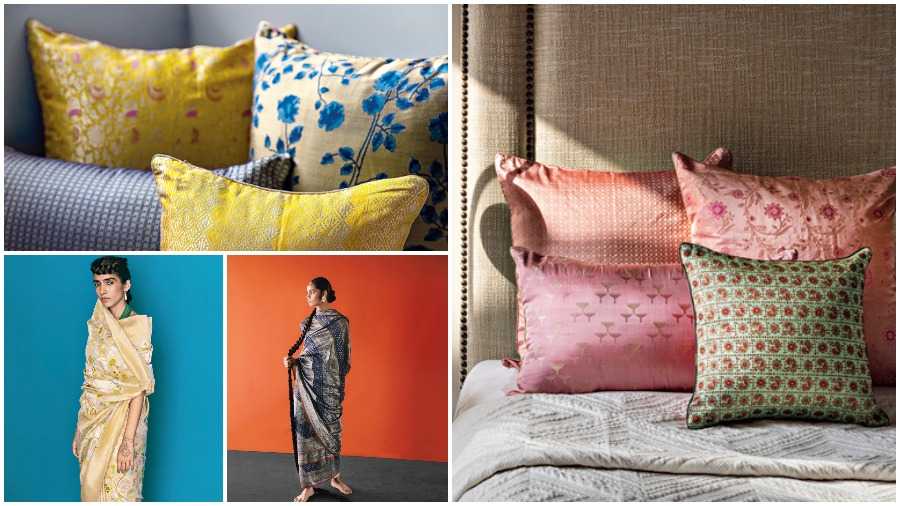Palak Shah, CEO, Ekaya Banaras, is one dynamic entrepreneur for whom the joy of trying new things is directly proportional to the smile she sees on the faces of weavers she calls “engineers of textiles”. “The joy is to make a difference and really create value and give the weaving space a new name, change the position of the way people look at weavers.... Give them that respect so that they can start living a good life and have their next generation come into the business,” she tells us when we call her to chat about a couple of new Ekaya Banaras ventures — The Revival Project and the launch of its home collection. While The Revival Project entails reviving, recreating and restoring saris, the home edit has started off with reversible cushions made from woven fabrics in indigo blue, blush pink, antique gold and pastels. A candid chat.

Given the sari lover that you are, The Revival Project must have made you go mad with joy?
More than me going mad with joy, it is my dad because it is a joy for him to see all these old techniques and be able to recreate them. Back in the days, these saris were not very complicated in the way they looked, but they were complicated in the way they were made. It is an absolute joy for me to see the memories attached with it or see how much people have taken care of it and how simple some of the saris are. With time we have all got into the mindset of ‘more is more’. In order to charge a certain price from a product, we tend to do more work on it, but the beauty is in ‘less is more’, always.
How old is the project? Why did you feel the need to do this?
The Revival Project had started last year and it was always in the pilot stage where I was just trying to see whether I can handle it or do it or how long it takes. To be honest, it’s been there for two-three years. We officially launched it this time.
I used to be in conversation with people... a lot of my clients and this was a pressing question for everyone, where they were like, ‘I have my daadi’s sari but it’s in tatters’. If I have torn my saris or lehngas, I knew I could get it fixed from Benaras. I thought why couldn’t I extend the same service to other people? We are only doing Benarasis as of now.
What is the process like?
First the client gives us the picture of the product and then we see if we want to recreate it or restore it. Once you are reviving it or recreating it, we discuss with the weaver how to recreate it and what are the technicalities of it and then the whole process of creating the sari starts. We ask the client what they want... if they want to change the colour. Those who give it to us to recreate it, are attached to the design as well, but the clients who give it to us to repair it, are attached to the products a lot.
Tell us about some of the pieces that have come to you...
There was a tissue sari that had come long back and it looked really simple but when we actually sat with the weaver, we realised just how complicated it was because the pleats of the sari were in different colours. You can have a gold warp running through the sari, but in the middle you can’t have a certain colour because it is difficult. After thinking for months on how to do it, we thought we had to dye the yarn, almost like an ikat sari. So, it became an ikat-meets-Benarasi. That was very beautiful but another challenge that we had while creating the piece more and more, was to convince the customer why it’s so difficult and expensive.
Is there anything from your closet that you would love to restore?
I have my daadi’s lehnga that I want to restore. It’s in tatters. When I was a kid, I had worn a real zari lehnga, made out of a Rangkat sari, which is also in tatters. I want to restore that as well because those designs are not made any more.
Give us some style tips ahead of the Pujas...
I do understand that it is a traditional event, I would go completely traditional. I wouldn’t try to modernise it and I would go back to the traditional drapes and recreate it in my own way.
You have also launched Ekaya Banaras’ home edit with a line of cushions...
The fabrics are all Benarasi, all upcycled and scrap fabrics which we decided to repurpose and create cushions out of. We started with cushions because they are the initial additions to the house and they are beautiful accents and that’s how we can start off by adding a little bit of Ekaya to your houses. This is to see how people respond to our cushions, whether they are happy keeping such beautiful and eclectic textiles in the house. Also, gifting is one of the major reasons why we are launching it at this point.
Do you love house shopping? What are you most likely to pick up?
I love house shopping and picking up sculptures and knick-knacks for the house... bedding and cushions, which is why I chose Ekaya’s first home line to be cushions.
